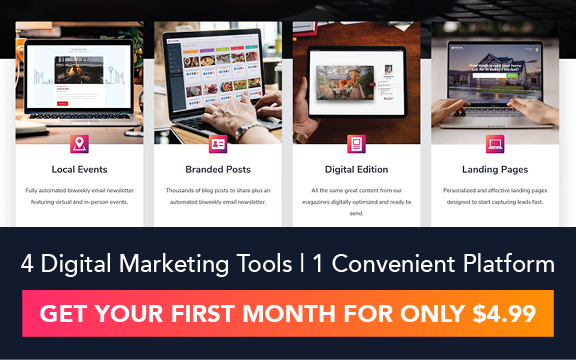Social media managers can get deep into the weeds when developing their content pillars and aligning them with an overall social media marketing strategy. They consider factors such as page authority, keyword optimization, backlinks, and a bunch of other technical aspects that only the professionals truly understand.
We won’t get that deep—your job is to be a real estate agent, not a social media manager. And, as the title of this blog post suggests, you’re busy. You simply need a strategy that will make it easier for you to give some structure to your content and, as a result, bring clarity to your content marketing efforts. My goal here is to give you that structure.
Don’t worry if you’re not particularly knowledgeable about content marketing or are just at the beginning stages. A content pillar strategy requires careful thought, but once you’ve determined your content pillars, putting a strategy into place isn’t difficult. On the other hand, if you have been producing content for a while but without much of a plan, you can use your existing content to select your pillars and decide how you want to move forward.
About content pillars
If you aren’t familiar with content pillars, let me answer a few of the more frequently asked questions about them before we get into developing a strategy:
- What are content pillars? Content pillars are broad topics or themes. Some people call them content marketing pillars, marketing content pillars, or buckets. They’re all the same thing. These pillars can then be further divided into clusters of subtopics.
- What is the purpose of content pillars? Basically, they make creating content easier by giving you a road map for planning, developing, and organizing your social media content.
- What are the benefits of having a content pillar strategy? A solid strategy will promote consistency across all your platforms, set expectations for your audience, and make your brand and content recognizable. Focusing your content marketing on a few key pillars will also promote your expertise to your target audience, enhance your authority and organic rankings (provided you post regularly), and lead to more traffic.
- What are examples of content pillars? The pillars selected by any marketer are best determined by what their target audience most values and needs. For example, if you are a real estate agent whose niche is single-family homes in [xyz] community starting at $350,000, you might develop content pillars for selling a home, buying a home, improving a home’s value, and about [xyz] community. Each pillar can then be broken down into more specific topics. The range of potential content pillars for real estate agents is extensive.
- How many content pillars should I have? As numerous as the options for pillars are, you want to keep the number manageable. There is no magic number, but I would suggest limiting it to five. Any more than that may cause you to lose your focus, and you might find that the content starts to overlap. Better to select a few pillars and divide them up into multiple subtopics.
Building a content pillar strategy
When determining your strategy and selecting your pillars, there are two guiding principles you should keep in mind.
1. Select pillars based on the needs of your niche audience
When determining what is most useful to your prospects and clients, it pays to do a bit of research.
Think about the questions you most commonly receive from clients—they’re excellent indicators of the types of content your audience would benefit from. To make sure you aren’t missing anything, challenge yourself and your team to record every question asked for the next month, and then review them to identify any patterns.
To help you refine your content pillars and subtopics, you might also want to ask your audience about their preferences. With social media, it’s easy to post a poll to ask questions and request feedback. For example, if one of your pillars is selling a home, then a natural subtopic would be about how to get a top dollar offer. In preparing to write content for this bucket, you could poll your audience about their tolerance for DIY projects and then plan your content accordingly.
If you’ve already been writing content, dig into your analytics to find the topics or themes that have encouraged the most engagement and examine what commonalities they might have. This information will give you valuable insight into what your audience wants.
2. Use the 80/20 rule
Imagine you had a friend who spent 80% of your time together talking about themselves. Showing little interest in you, you’d likely tire of them fairly quickly and find reasons not to be in their company. The same would happen if you used 80% of your content to directly promote your business—there would be little reason for people top follow you because most of what you publish wouldn’t be relevant to them. For this reason, you should rely on the 80/20 rule: devote 80% of your content to educating and entertaining your audience while reserving 20% to promotion.
To help them come up with that 80%, our clients enjoy the convenience and ease of our Digital Marketing Platform, which offers four tools in one. They use our automated Branded Posts with Facebook and Instagram Schedulers, Digital Magazine, and Local Events newsletter to provide educational and entertaining content and stay in consistent contact with their audience. (There’s also our Landing Pages product to help you capture leads.) All are personally branded to you with your image and company information.
How to create content pillars
As this is a beginner’s guide to content pillars, the steps for creating them that follow are fairly basic. Even so, they’ll make planning and organizing your social media and other content a more focused exercise. You’ll have an easier time coming up with ideas for content (lessening the dreaded “writer’s block”), be able to plan a content calendar far in advance of deadlines, and better position yourself as an expert.
- Create a pillar page. From the three to five content pillars you’ve identified, pick one and write a comprehensive, authoritative piece of content about that topic. Most pillar pages are “guides,” “how-to” articles, or “what is” pieces. For example, if one of your pillars is selling a home, your pillar page might be “The Home Seller’s Guide: Everything You Need to Know about Selling a Home.” Once developed, your pillar page functions like a hub for your content.
- Identify your cluster topics. Within this pillar page, you’ll address a host of different ideas related to selling a home, such as preparing your home for sale, selecting a real estate agent, selling FSBOs, navigating the negotiation process, and understanding key paperwork. Altogether, these are your cluster topics.
- Develop your content. Each cluster topic likely holds the potential for dozens of articles, which are called cluster pages.
- Duplicate the structure. Create a similar structure for your remaining pillars.
While pillar pages are usually long, written documents, there are a wide variety of formats for cluster pages. You could write a blog post, but you also might consider presenting your information using infographics, videos, social media posts, e-books, and more.
If you need some inspiration while brainstorming ideas for content, look to industry trends and news. Read the real estate section in respected newspapers, sign up to receive relevant newsletters, and subscribe to popular blogs. Our Branded Posts (one of the tools included in our Digital Marketing Platform) includes a library of thousands of prewritten blogs whose many categories and topics are certain to support one or more of your pillars—dramatically reducing the amount of content you need to develop.
You can also follow top agents on YouTube to see what they’re discussing and who they’re perhaps interviewing. Take their topics and put your own spin on them. You can expand on what you’ve watched or take an alternative position.
Check out Pinterest too—begin with a search for “buy homes” and “sell homes.” The top posts are indicators of the information people want.
Google Trends is another great way to learn what topics people are following. You can focus your search by geographic region, compare trending topics, and view trends across different periods.
You can also use a content ideation tool. Several companies offer free or trial versions, including:
Finally, consult community boards like Quora and Reddit. These sites allow users to ask questions about any topic and have other users respond. Peruse forums specific to your industry to identify common issues and spark ideas for your content.
Optimizing your content pillar strategy
You may find that content pillars and a basic structure are sufficient for your immediate needs. However, there is more you can do to develop a content pillar strategy that will enhance your SEO, online rankings, and authority (which are the primary reasons for creating content in the first place).
Internal link building
An internal link is a reference to other subject matter on your website. Providing internal links offers your readers a convenient way to access more information related to the material they are currently engaged with and enables you to unobtrusively push additional content.
Moreover, internal links improve your SEO. They give access to subpages on your site that otherwise would not be found with external links (references to or from other websites) that generally direct people to home pages.
Lastly, the more links to a particular page there are on your site, the more relevant Google deems that page to be.
As your library of cluster pages grows, you’ll have more opportunities to use internal links to connect pieces of related content. In particular, you’ll want to create links between your pillar pages and cluster pages and among related cluster pages.
Keyword selection
As noted earlier, content pillars are best selected based on your audience’s needs, which are revealed by high-volume keywords—words and short phrases used by large numbers of people to query a topic. The higher the number of searches for a keyword, the more interest there is in the topic.
There are many keyword-generation tools available to help you find and select high-volume keywords to use on your pillar pages and cluster pages, such as:
Strive to use different keywords for each of your cluster pages. If you repeatedly use the same or similar ones across your website, you may fall prey to “keyword cannibalization”—making it tough for Google to figure out which content it should rank highest. Essentially, you end up competing with yourself for rankings.
Repurpose content
Repurposing content is how busy real estate agents create multiple pieces of content from one robust source that can then be shared across multiple platforms.
If you begin with the content used on a pillar page, you can repost sections of it (with some edits) as a blog on your website or as an article on LinkedIn. You can also include content from your cluster pages in your newsletter, revamp them for posts on social media, and use them in emails. And consider recording videos for both your YouTube channel and Instagram Reels.
In the end . . .
Putting a content pillar strategy into place is an excellent first step when developing an overall content marketing strategy.
Rather than jumping in and producing content willy-nilly, defining content pillars will focus your efforts in ways that will make creating content more intentional.
But don’t be concerned if you already have a library of content. Simply conduct an audit of what you have, identify what’s been working well in terms of engagement and SEO, and see whether you can incorporate it into your new structure.
With a solid scheme in place, you’ll be able to produce content more efficiently, enhance your SEO by using internal links and strong keywords, and boost your authority as an expert.









 Apple Podcasts
Apple Podcasts
 Google Play
Google Play
 Spotify
Spotify



























